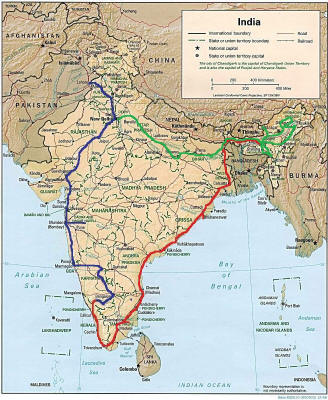 Assam
Assam
Friday
11 to Wednesday 16 April
2008, Guwahati,
 Assam
Assam
Jay was at the train station to meet us and we were finally a group. The first task was to find a hotel for Jim and myself and settle in. Jay was staying in a private home and did not need accommodation at least for a few days. The hotels are all near the train station so we walked from hotel to hotel to hotel. They were all full, even the ones we couldn't afford. The Bihu festival was starting on Sunday. This is the Assamese New Year festival, basically a spring festival and Assamese dancers and singers had come from many different parts of India to join in. We eventually found a hotel about 1.5 k away from the centre which we took even though it is a bit over my budget. By this stage just about anything would do. After freshening up we all went for a walk back to where Jay was staying, had lunch, went to the Internet and talked about ourselves and how to get permits. We got along so well that within 8 hours we were splitting the restaurant bills 3 ways and sharing a piece of cake between us - at the Cafe Coffee Day - along with a lovely cup of coffee each. We also set up a kitty as it is easier than each of us worrying about change. It also takes care of large notes as change is always a problem.
Friday evening Jay spoke to his host about permits and was told where Indians obtained theirs. It was open on Saturday so Jay arrived early and we headed straight there. Unfortunately it does not supply permits to foreigners but we were given some contacts and telephone numbers. We could not contact these people as they do not work on Saturday, but at least we have some department names. Bihu means that we can't do anything more until Tuesday. While Jim was busy making the calls the owner of the PCO returned. His name is Anjan Sarmah and he is the Chairman of the Pub-Guwahati Bihu Sanmilan Committee. The rest of the day was spent sight seeing.
Peacock Island in the Brahmaputra River has an ancient Shiva Temple that has been rebuilt several times. Destruction was usually caused by earthquakes as Assam is close to the Himalayas. While looking back across the river a young beggar girl came and asked for money which I refused. She then proceeded to prostrate herself touching her forehead to my feet and holding my legs. I must admit I stood there with my mouth open in amazement. When she realised this would not work she happily skipped back to her friends. It was all an act which did not affect her emotionally at all.
We also visited Nehru Park with its many statues both modern and realistic.
There are several Bihu festivals throughout the year but the most important one is Rongali Bihu, the spring festival. It is also known as Chotor Bihu or Bohag Bihu after the month or season. Rongali means full of merriment and it is all about enjoying spring with fun, laughter, dancing and singing. The most important message carried by the music is love and the spirit of all life. The festival started long ago in the villages under the trees. It gradually moved to stages in the cities and naturally modern technology is now incorporated. The instruments are still traditional ones such as bamboo flutes, drums, harmoniums, jew harps, Penpa made of buffalo horns), brass cymbals and bamboo clappers. The men dance very energetically. The women have more sinuous movements.
There is a myth that the goddess Bordoishila (eldest -bor; wind -doi; goddess -shila) rushes home to her mother just before Bihu. All this rushing creates a storm with lots of wind and rain. There was quite a storm on Saturday night, right in time for the start of Bihu. Part of the festival is the washing of the cows (13th) and of people (14th) with a thin paste of tamarind and water. This cleanses the body for the new year. Spring cleaning also takes place to remove all the baggage from the previous year and start afresh. New clothes are purchased and worn. Gifts are also given but they must be given before the end of New Year's Day on the 14th.
There are many different Bihu
festivals around Guwaharti which last anything from 2 to 5 days depending on
finances and the organisational committees. Sunday we went to the one put on by
the All Assamese Students Union. The singer was Debojit Saha, a young Assamese
from Silchar who won the nation wide Sa-Re-Ga-Ma-Pa contest put on by GTV. Many
people from the audience went onto the arena to be close to him. There was also
a famous actress. The dancers were dressed in traditional costumes. The women
usually wore red tops, skirts and golden scarves with red embroidery. The dances
are traditional farming dances showing agricultural activities. Some of the them
express a 'yearning for union'. What a lovely phrase. After they had danced for
a short while the audience joined in.
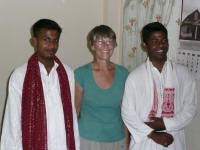
After the performances we were asked back
to the Students Union by two students Eloin and Raj for some typical Assamese New Year food. It took quite
some time to get there as so many people wanted to shake our hands and wish us
Happy Rongali Bihu. We were also interviewed for TV. Finally we arrived at the Students
Union and were treated to a small plate of New Year food consisting of Til Ritha,
Doi Chira and Laru. We were then introduced to the President who gave us a
Bihuwan each. This is a white cloth with red embroidery. The cloth is normally
called a Gamusa but when given to someone during Bihu it is called a Bihuwan -
Bihu gift.
In the evening we went to another Bihu festival with similar dancing and songs. They also had several plays with lots of dancing and singing. One involved a goddess with a lion, a peacock and several other characters. I could not follow the story. We stayed until midnight so it was quite a late night. Another involved a re-enactment of the Mahabharata.
Then on Monday we went to our third Bihu festival, the Pub-Guwahati Bihu Sanmilan. By showing our tickets we were escorted to the VIP seats. There was a competition for traditional Bihu dances going on when we arrived. There has been a lot in the newspapers about the value of competitions where large prizes are given. I think it is worthwhile though. Each group is judged by people who obviously have a great deal of knowledge about Bihu. One judge actually sang part of a song again to show the competitors how it should have been done. Others asked questions about Bihu or some aspect of the songs, dances and musical instruments. Not all knew the answers. This is one way of ensuring the culture is re-enforced. Later the winner was given a bronze Sarai (or Khala Khetra). Presenting a Sarai expresses good will. Sometimes food is put into it, e.g. apples or coconuts and it is used for praying to the god. Naturally everything was in Assamese so the above comments are my impressions of what was happening. There was a break after the competition then more songs and dances. One section was devoted to the memory of previous top class singers. The songs were sung by older people, perhaps they had known the singers. Another song was the music of a wedding ceremony with everyone having at least two skills from singing to playing several varieties of instruments. There was also a musical where coloured powders were thrown over the performers by other performers, rather like Holi. Flutes are used often and they give a lovely tone. The last dance we stayed for was a very energetic Punjabi dance performed by Sikhs. One of the singers was a boy of about 8 with a magnificent voice, but he was very nervous, frowning all the time and twisting part of his clothing. I enjoyed the music very much as it did not have the high pitched tones of Hindi music.
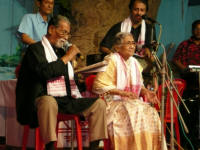
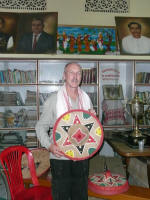
During the evening we were again interviewed on live TV being sent live to 22 countries throughout the world! I was asked if Assamese culture would help change the culture of the world! The straight answer of course is 'Your joking, it will have no impact at all'. Instead I spoke about how I felt other cultures should see and appreciate the Assamese culture instead. We were also given a Bihuwan, a souvenir book, crisps, soft drinks and later a typical Assamese meal with rice, dhal and a really nice tomato sauce. We finally left at 1:00am, another late night.
Tuesday was supposed to be a rest day
with Jim trying to make contact with the people he had already contacted about
permits. This was a dead loss but he did find the Assamese Tourist Office. The
woman said she could help but only just before 6:00pm. We decided to meet at Cafe
Coffee Day for a cup of good coffee. It is Bihu though and they had a special
menu where the simplest drink you could get was coffee with cream and chocolate
sauce plus two biscuits. We went elsewhere and eventually back to the Assamese
Tourist Office. The woman was not there but there was a pub. Jim, as an
Australian, was the one to spot it. About an hour later Michelle and Will from
Byron Bay, the same town where Jim lives, walked in. He had met them earlier at
the train station but not really talked to them. They have been in the north
east for 3 months and were full of information. They suggested we skip official
sources for permits as these took too much time and there was a lot of red tape.
Instead we should go through an agent who would cut through the tape. The woman
from the Assamese Tourist Office did not turn up at all that night which made
their advise very appealing.
In India everything starts late and goes on till late, therefore we decided to go to Kamakhya Mandir early and make the phone calls later. This mandir and several other temples are on the top of Nilachal Hill. It is an important centre for Shakti, female spiritual worship. Hindus believe that Shiva went on a destructive spree when his first wife Sati dies. He carried the body with him. Lord Vishnu used the Wheel of Destruction to chop the body into 51 parts. They fell all over the Indian subcontinent but when the body was gone Shiva came to his senses and stopped his destruction. The yoni (female genitalia) of Sati fell on this hill. Goats, doves and buffaloes are ritually slaughtered here, one of the few places of animal sacrifice in India. Perhaps that is why the Brahmins are dressed in red and yellow. We watched several young goats, some doves and one buffalo being slaughtered. The goats and doves were done very quickly. The front legs of the goats were held behind their back and there head placed between two poles. This stretches the neck and make the slaughter quicker. The goats complained a bit but I think mainly because of their legs being pulled back. The buffalo was a different story. It's front legs had to be held back by hand held poles and it's head placed between larger poles. It made much more of a fuss until it was in position. The Brahmin who performed the ritual killing first ensured the blade was very sharp. He spent a long time honing it. He then went through several rituals of praying and movements such as touching his forehead, face and chest. This was again quite a long process. In the meantime other sacrifices continued. As usual there is always more than one activity going on at the same time! Two women had asked for the sacrifice of the buffalo plus two goats. They sat quietly watching the whole process. The meat from the sacrificed animals is either donated to the temple or taken home by the purchaser. The buffalo carcass was still there when we left. I am not sure if the meat is considered beef or not. If it is considered beef presumably it will be sold to a Christian for consumption. The heads are always left behind, not sure why.
We were now ready to proceed with the task of sorting out the permits. Jim, our designated permit organiser, phoned Himalayan Holidays. The owner was in Guwahati on his way to the airport to take the plane to Delhi. He asked where we were, which happened to be almost outside the museum, so he told us to wait there for him. He turned up a few minutes later, gave us some brochures, took photocopies of our passports and Indian visas which we had already prepared, agreed that the permits should be valid from 26 April, told us where to deposit the money for the permits, gave us his cell phone number and told us to phone on Monday. Then off he dashed. All done in 5 minutes. It took us another hour to locate a branch of his bank and deposit the money. We will deposit his commission once we have the permits. There is a lot of trust involved here.
While we were waiting for him to
arrive Momito saw Jay, jumped out of her friends car, rushed across the street
and enthusiastically greeted him. Jay had spent 48 hours with her, her son,
daughter and mother on the train from Mumbai to Calcutta. They became great
friends during the journey. She invited us all to dinner that evening with her
family at the Delicacy Restaurant known for its traditional Assamese food. It
was a sumptuous meal. It started with a ginger and coriander soup. The base of
the main meal was a Thali with 6 side dishes accompanied by 2 fish dishes and 2
chicken dishes. Momita and her husband made the choices. The menu is long and we
certainly didn't have the knowledge to make choices. Everyone took some of the
additional dishes, rather like in Chinese restaurants. The meal was finished off
by a type of rice pudding. The traditional brass dishes were used for all the
courses. Superb!!!
Guwahati is a typical Indian city. There are motorbikes everywhere, fish are caught in the river and there is at least one tank. Both men and women carry enormous loads on their heads. We saw one man carrying a steel office cupboard about 1.5 meters high this way. The people are a mixture of races with Indian and Mongolian features mixed in various quantities. This is because China, Tibet and Myanmar are not that far away.
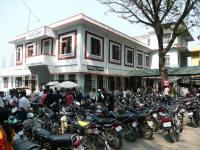
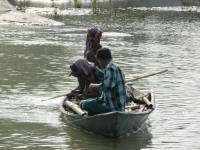
Thursday 17 to Monday 21 April 2008, Shillong, Meghalaya
We now have 10 days before the permits for Arunachal
Pradesh start and decided to go to Shillong and Cherrapunjee.
Cherrapunjee used to be the wettest place in the world with 11,873mm of rain per
year. Nearby Mawsynram now has the honour. We took our time leaving as the
journey takes 3.5 hours by shared jeep / sumo. The road winds up through the
green hills. There were no dramatic drops, just blind corners where everyone
overtook other cars - typical Indian driving. The road is
also being improved so
there were many road works in progress. We went through a heavy hail storm which
made driving more dangerous, especially since the windscreen wipers didn't work!
Since all the windows were closed the windscreen misted up quickly and had to be
constantly wiped. The same cloth was used on the outside to clear some of the
water off, by the driver while driving naturally!
We were dropped somewhere in Shillong, everyone had a different answer as to where we were. Eventually we were given a direction and headed off that way. The road went straight past a police station so we asked exactly where we were. It was also the place where we had to register so not only were we able to figure out where we were on the map we also took care of the registration process. Now we had to find a room at a hotel. The first few we tried were full. Eventually Jay sat down with the luggage as he needed to eat and Jim and I went off on our quest. After looking at several hotels we ended up at one just up the street from where Jay was, the second one we had looked at. If we had had a detailed plan this would have been a good place to book ahead. My bag was thoroughly soaked. Half the clothes had to be hung up to dry. Since one of the zips has also given up it is now time to buy a new, hopefully more waterproof bag. It was early to bed for all of us with Friday as a day off for me. In reality this means sleeping late, washing clothes, writing up the website and going with Jay and Jim to sort out our trip to Cherrapunjee.
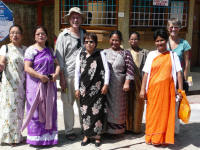 We visited the Don Bosco Museum for
Indigenous Cultures. It is very professionally laid out over 7 floors covering
pre-history, the land, the cultures, music, village life, traditional
technology, weapons, costumes, housing and religions of the tribes. There are
more than 200 tribes in the North East and they seemed to have something from
most of them. The last gallery was the media gallery where we watched a
documentary on the North East but we could have chosen any of the traditional
dances to watch instead. These were all stored electronically. The next step in
their desire to improve the exhibition is to digitise the sounds made by the
musical instruments and allow the models of the people to talk to the viewer. Hi
tech is the way they are going. Besides the museum they have a research centre
where the tribes are studied to improve knowledge of the cultures and to
preserve their memory. As is to be expected modern life is gradually changing
the cultures. The aspects I found most interesting were the carvings made from
bamboo roots, some of them were very elaborate, and the religious gallery. This
covered the various religions of the world.
We visited the Don Bosco Museum for
Indigenous Cultures. It is very professionally laid out over 7 floors covering
pre-history, the land, the cultures, music, village life, traditional
technology, weapons, costumes, housing and religions of the tribes. There are
more than 200 tribes in the North East and they seemed to have something from
most of them. The last gallery was the media gallery where we watched a
documentary on the North East but we could have chosen any of the traditional
dances to watch instead. These were all stored electronically. The next step in
their desire to improve the exhibition is to digitise the sounds made by the
musical instruments and allow the models of the people to talk to the viewer. Hi
tech is the way they are going. Besides the museum they have a research centre
where the tribes are studied to improve knowledge of the cultures and to
preserve their memory. As is to be expected modern life is gradually changing
the cultures. The aspects I found most interesting were the carvings made from
bamboo roots, some of them were very elaborate, and the religious gallery. This
covered the various religions of the world.
We walked to the museum, over 2 kilometres, passing through an older section of the town where colonial houses were still being occupied. These houses used to predominate but are being gradually replaced by modern architecture. Since the tour took well over an hour we caught a taxi back.
Jim and Jay went to an archery contest. It is basically gambling on how many arrows hit a barrel using only the last 2 digits and dropping the hundreds. So if 324 arrows hit the barrel the winning number is 24. Many archers lined up to shoot at the barrel in a given time period. Those arrows that hit the barrel were then counted and the winning number declared. A fascinating way of gambling.
We went on a tour to Cherrapungee as we could not contact the 2 known hotels to ensure there was accommodation available. Places visited were Duwansing Syiem View Point - pretty; Ramakrishna Mission with its temple and museum of the Kassis people - not very interesting especially after seeing the museum in Shillong; Nohkalikai Falls with a view of Bangladesh obscured by clouds - would be better just after the rainy season; An Eco Park with the Sunrise and Sunset Falls; Khoh Ramhah (or Mot Trob) with the sibling stones and a view of Bangladesh through the mist; Thankharang Park with greenhouses, monoliths and a misty view of Bangladesh; Mawsamai Cave which we did not go into.
The scenery generally was very green
with mist and clouds, no doubt why they call it the Scotland of the east. It was
great to drive through. The best experience though was at Mawsamai Caves.
Everyone was supposed to order lunch, go into the caves and then return to eat
lunch. The passengers mobbed the poor girl trying to take orders (typical Indian
queue) and she was becoming very stressed. We decided to go with a bag of crisps
and a drink as there was sure to be absolute chaos when the food was being
served. Jim noticed some food being cooked at the back of one of the stalls and
asked if there would be some lunch. There was. It consisted of rice, dhal and
cooked cabbage, a very simple typical Khasis meal. What a pleasure.
The monoliths are part of the funeral rites and ancestor worship. There were quite a few near various houses. I don't know how long they had been standing there and if the custom is still followed though.
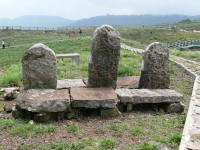
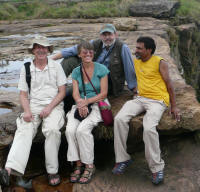
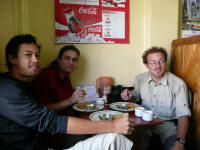 While we were waiting for the tour to
start we met Iria, a German doctor recently arrived from Bangladesh. When we
mentioned we were on our way to Tawang she said she knew of a man who also
wanted to go there. We finally met Carlos, a Canadian, quite late in the evening
and agreed to meet for breakfast after which we could phone Himalaya Holidays
and see if he could be added to the permit. Iria brought Olivier, a Belgium, to
breakfast as he also wanted to go to Tawang. Unfortunately neither could be
added to our permit as it was already in the process of being granted and a
change would mean starting all over again and paying again. Carlos and Olivier
may go together though. If so we might meet them in Tezpur and travel together.
While we were waiting for the tour to
start we met Iria, a German doctor recently arrived from Bangladesh. When we
mentioned we were on our way to Tawang she said she knew of a man who also
wanted to go there. We finally met Carlos, a Canadian, quite late in the evening
and agreed to meet for breakfast after which we could phone Himalaya Holidays
and see if he could be added to the permit. Iria brought Olivier, a Belgium, to
breakfast as he also wanted to go to Tawang. Unfortunately neither could be
added to our permit as it was already in the process of being granted and a
change would mean starting all over again and paying again. Carlos and Olivier
may go together though. If so we might meet them in Tezpur and travel together.
Tuesday 22 April 2008, Silchar, Assam
We had paid a deposit on the Sumo for Silchar leaving at 7:00am. We were up and ready and waiting well in time. The alarm clock and time are the only things my cell phone is useful for at the moment! We were told the Sumo was not working by another operator but it took over half an hour to have this confirmed by our operator and to get our deposit back. By then all the other Sumos had gone! Maybe a deposit was a bad idea. A friendly local, Amos, told us there was also a bus to Silchar leaving at 10:00 am. He showed us where the office was helped us organise the tickets so we treated him to tea and cake. The road goes through the Jaintia Hills. There were lots of green hills, pine plantations and cultivated valleys. Unfortunately there was also evidence of slash and burn agriculture with its associated deforestation. There were also plenty of monoliths beside houses near Shillong.
We passed a queue of trucks going the other way, at least 5k long. Not sure of the reason but even the cars and buses were caught. Next we came across a queue on our side of the road. The bus driver thought he could be clever and moved over to the wrong side of the road to pass them. Bad move. The army were there trying to control impatient drivers. They waved our bus, and the ones who had followed us, right over to the side of the road to allow the oncoming traffic to move forward. Of course the queue we should have been in also started moving, but we were stuck. Jim could see what was happening from his window. The body language of the army personnel conveyed the message that 'you, the bus driver and his followers, could stay there and wait for over 15 minutes as punishment for being stupid'. Eventually we were allowed to cross back over to the correct side of the road a rejoin the queue.
The gradient was so steep in places that the trucks needed chocks under their wheels.
Houses are often made of bamboo slats.
These are woven in panels and used for the sides of the houses. Some are woven
in a diagonal manner and some are straight. They had to pump the water up from the river, much better than
carrying it up. We are back into Hindu territory. Shillong had many Christians.
The journey was long and tiring. We all had a snooze at some time or another. At one stage I was very deeply asleep, I think someone was trying to wake me because I was obstructing a spare seat. It was late by the time we arrived in Silchar. We decided to go to the railway station first so we would know where it was. We already had our tickets and it was to be another early start. We also expected there to be hotels nearby. Jim hired an auto rickshaw. When all 3 of us climbed in the drivers face fell in horror. But he did take us to the station and charged almost double. I guess he felt the wear and tear on his vehicle from 3 people with luggage deserved the extra. Next step was the hotel. We ended up walking halfway back to the bus station! The first hotel we came to was full. The second had rooms. It also had mosquito nets and large cockroaches. After a lovely cold shower we were in bed by midnight. The night was hot and humid, we were definitely back down into the lowlands.
Wednesday 23 April 2008, Lumding, Assam
This time we took 3 peddle rickshaws to the station. The first man said he would only take 2 people so we assured him he only had to take 1, that made him happy. He quickly organised another 2 rickshaws. In the early morning heat it was too far to walk.
Shillong only has 1 platform where our
train sat. The incoming train stopped on the next set of tracks and every one
climbed off, then up into our train to go through to the platform. Those with
piles of luggage had to wait for our train to go. The reason for catching this
train was to see the scenery. We had heard from several sources that it was an
amazing journey. It was lovely scenery with green hills and valleys.
Unfortunately it is not possible to break the journey at Haflong for security
reasons. Doing the trip over 2 days would be much better, especially as you
reach Haflong in the late afternoon. It would also be better to do the journey
in reverse as the best views are on the right going down and the seats are on
the left.
The train was only half full when we left Silchar, what a pleasure! Then we stopped at Badapur and the train filled up completely. At least we had reserved seats but it still didn't stop 5 people sitting on a seat for 4. They also sat in the isles so getting up and moving about was out of the question. Then there was the side of the engine and of course the roof. The army was out in force. There was a group on the train who got off at every stop and patrolled around the train as well as additional men at several stations. Some stations were in the middle of no-where, no platform, no name, no indication that it was in fact a station, but people got on and off so it must be a regular stop.
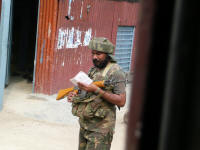
There is a lot of construction going on. The current line is narrow gauge and they are putting in the standard gauge.
At one stage there was a mother, grandfather and 3 children. The baby was not toilet trained and was still on the breast - on demand feeding. The two youngest were boys and both were demanding. Baby needed to pee. So Mum stands him on the floor, pulls his pants down and he did his thing. Now I know why my bag got wet on other trains when I put it on the floor. At least it is clean wee.
Once again it was a late night. The train was 2.75 hours late, arriving at 11:30pm. At least we found a hotel easily with 3 single rooms for once. There were lots of mosquitoes and even though the rooms were sprayed and there was an electric mosquito repellent, I was thoroughly bitten. Still humid and hot so the cold shower went down well. It was very noisy in the morning because the rooms were near the kitchen.
Thursday 24 April 2008, Guwahati, Assam
We wanted to go to Nagaon as this was
close to Kaki which is close to a confluence. A confluence is where an exact
integer of latitude and longitude meet (see
www.confluence.org). Jim has a side project to visit 4 confluences in Assam.
The bus left on time but before it managed to leave town it came across a bridge
which had collapsed, presumably during the night. The bridge would obviously
take at least a day to fix so we were taken back to town and the bus was
cancelled. That was the end of trying to get to that confluence.
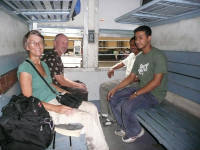 Our other option was to take the train
to Guwaharti, then a bus to Tezpur, our stepping off point for Arunachal
Pradesh. There was a fast passenger train leaving at 3:00pm that is not in
Trains at a Glance nor the online system. It is second class only which means
hard wooden slats to sit on and lean back against. At least it wasn't crowded as
there are no reserved seats in second class. The route goes through the
Brahmaputra valley which is wide and flat. We ate food from the vendors who
hopped on and off the slowly moving train at each station. One snack was spicy
beans served on paper with a piece of palm leaf as a spoon. The food here is
much more spicy than the rest of India, but very nice. We arrived in Guwaharti
reasonably early, found a hotel and went straight to bed. We had plenty of time
in the morning to catch the bus to Tezpur.
Our other option was to take the train
to Guwaharti, then a bus to Tezpur, our stepping off point for Arunachal
Pradesh. There was a fast passenger train leaving at 3:00pm that is not in
Trains at a Glance nor the online system. It is second class only which means
hard wooden slats to sit on and lean back against. At least it wasn't crowded as
there are no reserved seats in second class. The route goes through the
Brahmaputra valley which is wide and flat. We ate food from the vendors who
hopped on and off the slowly moving train at each station. One snack was spicy
beans served on paper with a piece of palm leaf as a spoon. The food here is
much more spicy than the rest of India, but very nice. We arrived in Guwaharti
reasonably early, found a hotel and went straight to bed. We had plenty of time
in the morning to catch the bus to Tezpur.
There are many different ways of carrying loads.
Friday 25 April 2008, Tezpur, Assam
At least we arrived in the light and found a triple room. I was able to catch up on some basic washing and hang it on a line on the roof where it dried reasonably quickly. We were supposed to meet Carlos and Olivier to see if they had managed to obtain a permit but were far too tired. Actually we knew they had managed as they were on the same permit we were on along with 4 other people. So much for it not being possible to add them to our permit. More commission for the agent!
We really wanted a decent meal and ran into a local named Vishal who took us to Hotel Annapurna in RS Road. We had a great fish thali at a reasonable price. Once again it was early to bed and late to rise.
Saturday 26 April 2008, Bomdila, Arunachal Pradesh
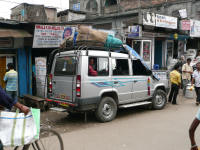 The Sumo to Bomdilla was supposed to
leave at 11:30am. The Indian woman behind said it did leave at 11:30am Indian
Standard Time. This translates into an hour later. She was just as sarcastic
about the inability of Indians to be prompt as we are.
The Sumo to Bomdilla was supposed to
leave at 11:30am. The Indian woman behind said it did leave at 11:30am Indian
Standard Time. This translates into an hour later. She was just as sarcastic
about the inability of Indians to be prompt as we are.
There was a driver and an assistant. The assistant either sat in the front on with the driver on the drivers seat or when there was space he would climb through the back window onto the back seat! Oh to be so slim, flexible and fit. It was a fast drive where we were swung around a corner every few seconds. The young toddler in front finally succumbed to car sickness which meant the driver had to stop for a short while, a bit slower around the curves would have been better. We had several near misses where braking hard by both the oncoming car and our driver was the only thing to prevent a head on collision.
It was generally misty and cloudy so
we did not see much of the views. Huts were perched on the side of the road. The
floor was on a platform with poles reaching down the mountain side. The huts
were built so the front door was at road level. It would not take much for
the whole structure toslide away. If they encroached on the road though no cars could
have gone through as the road was so narrow. There were lots of satellite
dishes. Years ago it was TV aerials. New technology reaches everywhere.
There was a permit check at Bhalukpong where only 1 of us had to sign and they ticked off our names on a copy of the permit which they kept. So much for needing 4 people together. Military presence is obvious. The road passes through 30 kilometres of army bases, one after the other.
Once again we arrived after dark. We sat down with Mr Wonge from Himalaya Holidays who had organised the permit and had black ginger tea. Naturally we assumed we could go on to Tawang the next day. No, he needed two days notice as the Sumos were already full. He said he would see if there was a possibility of reserving seats from Tezpur but we would have to pay the price from Tezpur to Tawang. While he was chasing this up we found a reasonably priced hotel - just not worth the money though. The meal was reasonable but the mattresses very thin, the blankets barely adequate and no hot water. The electricity also went out leaving us with candles. Once we had settled in we returned to Mr Wonge to find out about our trip to Tawang. He served us Yak Butter Tea. This is tea made with milk and butter. Jim's description was good - just like cheesy water. I won't order it but if I am offered it and cannot refuse I can drink it. We had to check back the next morning to find out about transport.
Sunday 27 to Monday 28 April 2008, Dirang, Arunachal Pradesh
Miscommunication meant we thought we
had seats. Then Mr Wonge arrived and dashed our hopes. We had several options,
stay in Bomdila for an extra day and pay for a seat from Tezpur to Tawang, stay
longer and have seats on the Bomdila to Tawang Sumo or go on to Dirang, spend a
day there and go on the Bomdila to Tawang Sumo. Since we intended to change
hotels anyway we decided to rather go to Dirang. There was one leaving at
10:30am but before we left we made sure we had tickets for Tuesday.
We arrived in Dirang in the early
afternoon, it is only a short ride further on, booked into the same hotel as
Carlos and Olivier and rested. We have 2 deluxe double rooms. This means a
sitting room, a bedroom and a bathroom with geyser. The pigeons in the roof are
a bit noisy in the morning. I have a cold so I
am not feeling the best. The hot shower and warm bed were very welcome. The
electricity is unreliable and the shower had to be planned with that in
mind. I did manage to write up some of the website though. We met up with Carlos
and Olivier. They were leaving the next morning and intended to go to Yang and
then on to Mokto to hike northwards. We met them again the next morning. The
Sumo was having problems and needed to be repaired. Eventually they called Mr
Wonge who phoned around and found a friend of his to drive them to Yang. We
found out later in Tawang that they
stayed the night with a monk as there were no hotels and could not get a lift to Mokto so
went through to Tawang instead.
Breakfast was paratha again. Paratha is a flat bread served with a small bowl of potatoes cooked in a spicy curry sauce. I have been having this for breakfast for quite a few days now as that is the only choice. Bread and potatoes for breakfast. Who would have thought! Since we were here for 2 nights I sent my washing to the laundry and put on long sleeves as it is cooler up here.
We decided to visit Old Dirang. It is
a 5 kilometre walk but we were lucky and got a lift on the back of a bakkie
(utility, pick-up). It did not stop at the turn-off to old Dirang and we ended
up at Sangti. A very small little village with stone houses. We now had to walk
10 kilometres back to the turnoff. It was interesting to see cultivation with a
wooden plough. At one point Jim climbed up an embankment to look at a plant
while Jay and I went on. Jay walks fast and was soon 50 meters ahead. I noticed
a car slow down and have a quick chat with him but assumed he was being offered
a lift. Next a bakkie comes past and Jay climbs in and beckons to me. I refused
as Jim would be left behind. I went back to look for him, couldn't find him and
decided to continue on. I did get photos of road workers. They are mainly women
and they break up the larger rocks into smaller ones which are then taken away
by trucks. The rocks have slipped down the mountain onto the road and need to be
removed. This labouring work is part of a campaign to provide 100 days work per
family per year where the adults are willing. Eventually I reached the turnoff to find both Jay and Jim waiting for
me. Jim had gotten a lift with some monks and had only managed to get the driver
to slow down to tell Jay. That is why Jay got into the bakkie. He thought I was
waiting for a more comfortable ride in another car of monks following on later.
Talk about poor communication!
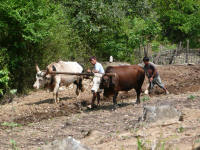
We saw Old Dirang including the
remains of a very small partially renovated stone fort. Once again satellite
dishes grow from the tops of houses. We sat down for a rest and watched a monk
cleaning his car and a pregnant women walking along carrying a load on her back
suspended from her forehead and knitting, talk about multi-tasking. We headed
back to Dirang and were almost at the turnoff
when the monk in his sparkling car drew up and offered us all a lift. This time
Jim was behind but the monk reversed to fetch him. The monk is managing the
construction of a new monastery in Dirang.
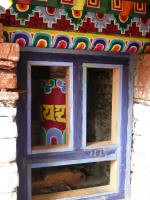
Surprisingly my legs were fine. I have obviously become much more walking fit over the last few months.
Tuesday 29 April to Friday 2 May 2008,Tawang, Arunachal Pradesh
We left by 8:00am and sped up the mountain and over Sela Pass without stopping. A pity, because although it was misty in the distance there is an archway. The pass is 4,176 meters high and passes by Paradise Lake which had a thin film of ice on it. Perhaps on the return journey. It is significantly colder on the north side of the pass. The roads are built by BRO (Border Roads Organisation). They have slogans everywhere such as: Go slow, someone is waiting for you at home; Better to be Mr Late than Late Mr; Don't fly, arrive alive; Time is money but life is precious; careful of my curves. Pity no-one seems to take note of them! We had to brake very sharply several times to prevent an accident. We saw one accident between 2 motor bikes. One overtaking the other. The one being overtaken fell over. Neither rider had helmets or protective clothing. The one who fell broke one slip slop but was otherwise unhurt just very angry and his bike would not start again. The solution - coast all the way down the mountain to a mechanic.
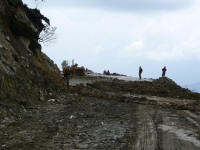
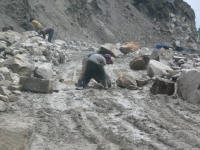 The roads were not very good. There
was much evidence of land slides and half the road being washed away. Maybe
because it is spring and the snow is melting. The bad areas are being worked on,
mostly by women. Maybe this is part of the provision of jobs scheme. The employment is in labouring jobs. So where
are the men?
The roads were not very good. There
was much evidence of land slides and half the road being washed away. Maybe
because it is spring and the snow is melting. The bad areas are being worked on,
mostly by women. Maybe this is part of the provision of jobs scheme. The employment is in labouring jobs. So where
are the men?
We had to stop to put in a jerry can of fuel which is stored in a shop on the way. I was amused by the funnel, a plastic bottle with the bottom cut off just like Pieter uses.
Once again the army was very much in evidence. Each regiment has a name, the one I liked best was the 'Powerful Mix' Regiment.
At least we arrived in the light at about 2:30pm and were met by the manager of the Gorichen Hotel. Mr Wonge of Himalayan Holidays not only arranges permits, tours, treks and Sumo rides he also has 3 hotels. It is a nice hotel and we are paying off season prices even though it is still officially the high season, so it is a good deal. We have a geyser for the bucket shower and a heater in our room. The warm winter woollies have come out and are in use. Tawang is 3,500 meters high and it is still cold although only the tops of the mountains have snow.
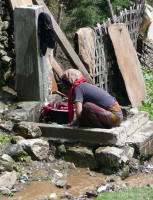
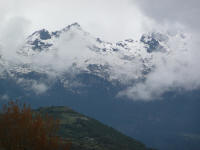
Note: Tawang is 508 kilometres from Lhasa, but the border is closed. The Dalai Llama came through Tawang when he fled from the Chinese.
I slept the afternoon away as I have a bad cold with a very runny nose but no fever.
Next morning after breakfast of paratha (this time with some dahl and green veg as well as the potato, much better than just potato) we visited the 17th century Tawang Monastery which perches on a spur in the mountains. It is a 3 k easy walk from the town but once there it is difficult to decide which entrance to take as there is lots of construction in progress. We visited the museum with its personal items of the 6th Dalai Llama and his mother. He was born nearby. There were also butter sculptures which will melt if put in the sun - to show the impermanence of all things. The Gompa or prayer Hall has an 8 meter high gilded statue of Buddha. There is also a library which was closed.
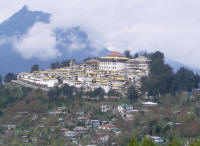
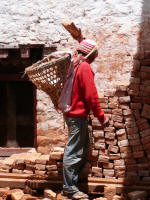
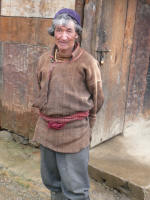
By this time it was just after 11:00 am and school came out. The school children are aged from about 6 to 18 years old. All are monks and carried a bowl. A drum had started up as well so we hung around to see what would happen. Eventually the monks filed into the Gompa, oldest first, youngest last. Then the dignitaries arrived. The head of a monastery near Mysore (not Sela where I visited) was on a visit. He blessed the local people who had lined up and went upstairs. Carlos and Olivier were there as well and the 5 of us went into the Gompa. Extra mats were brought in and we were invited to sit next to some very young monks. It was lunch time. Prayers were chanted while lunch was served, rice with cashew nuts and raisins on paper plates and butter tea in the bowls. We were given paper cups. The prayers continued until the monks serving the meal were seated, then everyone ate and drank. After that more prayers were said while money was distributed to the monks. Everyone got 10 rupees. Some received hundred rupee notes, up to 2,000 rupees. I assume the 10 rupees is pocket money and the other is for special needs, maybe new clothes or books. Young monks received the hundred rupee notes as well as older ones. Once the prayers were finished the monks left and we followed. They and the locals were all standing around so we followed suit. We could see musicians setting up a drum and large horns. Then the dancers came out. They were all in costume and masked. The dance was performed in a circle with twirling motions. It was obviously put on specially for the visiting dignitary. How magical for us.
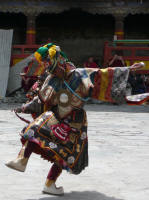
The next two days were rainy. We took the time to relax in our heated hotel room.
Saturday 3 May 2008, Bomdila, Arunachal Pradesh
We had to get up early to catch the
5:30am Sumo. Hard for me! Jay was heading straight for Tezpur, a 16 hour plus
journey, but Jim and I decided to spend the night in Bomdila where we could sort
out the permit extensions in person with Mr Wonge and break the journey.
We did stop at the top of Sela Pass even though it was snowing. However, the snow turned to rain a few kilometres on.
We spoke to Mr Wonge and paid him for the permits which should be ready Monday evening.
Sunday 4 May 2008, Tezpur, Assam
Jay had booked us into the same room in the same hotel as before so we knew exactly where to go. He had also found out about the buses to North Lakhimpur and that Sumos were unreliable. Another early start tomorrow.
Monday 5 May 2008, North Lakhimpur, Assam
The journey was uneventful. Across the river plain, past tea plantations with leguminous trees growing among the tea bushes to shade them and rice paddies.
The first task was to find out the status of our permits. They would be ready by 5:00pm. On this basis Jim paid a deposit on a Sumo leaving at 7:00am. By 5:00pm the permits were still not ready but would be ready by 10:30am tomorrow. At least we could change the Sumo to one at 11:30am. Now we just need the permits to arrive on time. They are being faxed to a PCO.
We ate at the Hotel Himalaya. The food was average but the bill bore no relation to the food ordered, INR 520 instead of INR200! The waiter had charged us for every dish that came with the fish Thali plus 2 of Jim's chicken and overcharged on the drinks. When we pointed to the Thali on the menu he decided we had ordered fish curry, so why bring us dhal and vegetables? Eventually I wrote our bill out and calculated the correct price. The manager was happy. I hope the waiter got a good talking to.
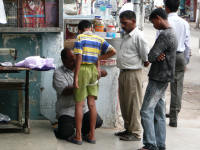
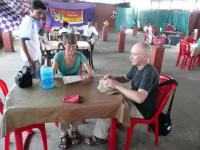
Tuesday 6 to Thursday 8 May 2008, Hapilo (or New Ziro), Arunachal Pradesh
Everyone was packed early and ready to go. My breakfast was an omelette with toast, butter and jam. What a lovely change. The permit had not arrived by 10:00am. Mr Wonge said it should be there soon. It eventually arrived at 11:30am. So while Jim dashed off to get a photocopy, Jay picked up his and Jim's bags and I headed for the Sumo stand to make sure it waited. Indian Standard Time worked for us. They were still waiting and were very happy to see me. Jim and Jay arrived soon after and then we had to wait another 10 minutes for .. who knows. We finally left at about mid-day.
We had a cowboy driver again. He sped around corners and only slowed down when the uphill forced him to. He also made very aggressive gestures to drivers coming the other way who did not get over in time and those he had difficulty in passing.
The scenery was great, tall hills and deep valleys with steep sides. At first there was virgin forest but slash and burn agricultural methods soon took over. There is a hydro electric scheme which did not look very large. Perhaps they will not fill all the valleys with water.
We arrived in Ziro (pronounced Giro, soft g) about 5:00pm and started looking for a hotel. Surprisingly there was very little available but we did find two double room with geysers. Ziro itself is quite small and everything closes down by 7:00pm. Then again everyone is up by 6:00am.
We had a decent meal at the United Restaurant owned by Bath (pronounced Bart), a hot shower and early to bed.
Next morning was spent washing clothes and pottering. Jay and Jim had a chat with Bath who offered to take us to a village in the afternoon. We hired an auto rickshaw and went to Hong which is the largest Apatani village in the area. The houses are usually made of bamboo and built off the ground. The original reason was to allow pigs to be kept underneath the house. The tradition continues even though pigs are now kept elsewhere. There are tall 'babo' poles topped with cross pieces and dangling balls to apparently signify the number of sons in the family. If this is true then there is only one son per family, unlikely! There is also a much larger 'babo' for each clan. Each clan has its own 'lapang' platform for men only meetings. These are built off the ground and can be made from bamboo, timber (some of the large planks are very old), or concrete. Most houses seemed to have a 'kharang agyang' or fertility totem. 70% of the population still follow the old 'Donyi Polo' religion. The rest have converted to Christianity. 'Donyi polo' is based on the sun (the goddess) and moon (the god) with the concept of light being spread equally across the world and humanity; of helping each other and that every action has an equal reaction. On special occasions a Mithum (Bos Frontails) bull is sacrificed. These bulls are large and have very wide foreheads. Bath then offered to show us his village, Hari.
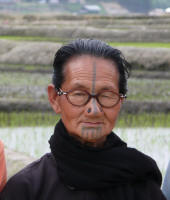 On the way we
picked up an old Apatani woman and gave her a lift. In return we took group
photos of Bath, the driver, the woman and 2 of us. Jay's 10x zoom came in very
handy. The Apatani women were considered very beautiful and were captured in
battle to become brides, particularly by the Nishi. Therefore they were tattooed
and had nose plugs placed in the sides of their noses. This is no longer done as
the inter tribal wars have stopped. Some woman have had the nose plugs removed
and sewn up. The Hari village was very similar to the Hong village. However Bath
invited us for tea at his brother's house. It is built in the typical style.
Inside is a large room, obviously living cum kitchen, with some smaller rooms at
the back. I assume one was a bathroom. They had the traditional central fire
place but also running water, a gas cooker, electricity and a solar panel for
when the electricity stopped. All the mod cons in the traditional hut. There
were also 'kharang agjangs' and other evidence of the 'Donyi polo' religion.
On the way we
picked up an old Apatani woman and gave her a lift. In return we took group
photos of Bath, the driver, the woman and 2 of us. Jay's 10x zoom came in very
handy. The Apatani women were considered very beautiful and were captured in
battle to become brides, particularly by the Nishi. Therefore they were tattooed
and had nose plugs placed in the sides of their noses. This is no longer done as
the inter tribal wars have stopped. Some woman have had the nose plugs removed
and sewn up. The Hari village was very similar to the Hong village. However Bath
invited us for tea at his brother's house. It is built in the typical style.
Inside is a large room, obviously living cum kitchen, with some smaller rooms at
the back. I assume one was a bathroom. They had the traditional central fire
place but also running water, a gas cooker, electricity and a solar panel for
when the electricity stopped. All the mod cons in the traditional hut. There
were also 'kharang agjangs' and other evidence of the 'Donyi polo' religion.
Later we had pizza at Bath's restaurant. Naturally he cannot obtain all the right ingredients but it was an excellent pizza with some Indian spice to it.
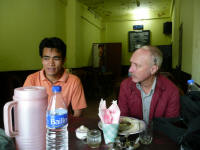
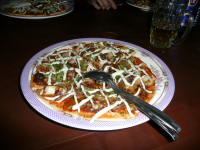
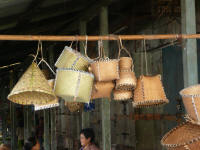
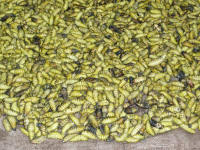
Next morning we were ready to leave for Daporijo. I must admit I slept in and let Jay and Jim do all the running around and asking questions. I also had Idly for breakfast, so much better than bread and potatoes. The process of leaving was to go to an unmarked spot where the sumos from Itanagar stop. If there is space you can get on. Because of the elections in about two weeks everyone is on the move and there was no space for any of us. A local woman went back to town to hire a sumo for 7 people, the number wanting to go to Daporijo. She found one for INR4,000. One man said his share was too much and actually found a place on a sumo. She went back to try and bring the price down and managed INR3,000. Everyone left agreed so she went back to fetch it. In the meantime the price went up to INR3,500 and the old man decided to go back home. She cancelled the sumo. It took us a while to realize this. The only thing to do was to go back to the hotel and hire our own sumo for the next day. This we did, now we will have to wait and see.
Because of the delay we managed to get to the ethnic workshop and sales centre. Unfortunately the sales centre was closed for renovation but there were some people in the various workshops. These included spinning and weaving. There was also a woman using a hand knitting machine just like those used in SA about 20 years ago. There was a shop nearby where Jim bought a scarf. Taku, an Apatani who taught English at a local high school helped with the sale. He then offered to bring some rice wine around in the evening. This he did and we had an intellectual conversation covering the "Donyi polo' religion, Newton and quantum physics. So now Jim and Jay have had some rice wine. I had a small sip. It is very strong with a zing to the taste.
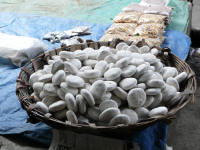
Friday 7 May 2008, Daporijo, Arunachal Pradesh
The sumo arrived a little late because the driver had just come from North Lakhimpur. A little scary since he had to now drive for another 6 to 7 hours! Jim made sure the owner, who came with us, understood we would be taking extra passengers to reduce our costs. While we were filling up with diesel near the sumo stop Jay walked up to the sumo stop to find 5 passengers. When people realised there were seats available there were enough for at least 2 sumos. One of our passengers had seen us the day before but assumed we had left. Jim and I shared the middle seat with one passenger. An old man asked Jim if 'Please Sir can I not fit in that row?' Usually there is 4 crushed into a row. I felt sorry for him but since we were paying quite a bit more than the others (we charged the standard price) both Jim and I wanted our comfort. I hope he got a lift in the end.
The driver was slow and continuously hooted the horn. I don't know if the owner was along to check out his skills. In fact I am not sure why the owner came along anyway.
The route took us through the Hillberry tribal area. Their houses were all the same basic style, i.e. large oblong structures built off the ground. The materials used differed dramatically. Roofs could be of the traditional Palmyra leaves or thatch, corrugated iron, flattened metal drums held on with bamboo, rocks or wood. The sides could be made with the traditional flattened bamboo poles woven in various patterns, sometimes plastered with mud or flattened metal drums, even a few wooden walls. The supporting structure was made of wood or concrete pillars. Steps were of wood or concrete. Occasionally they were made from a single log with steps cut out. There was electricity in all the houses we saw and quite a few satellite dishes. It rained most of the time.
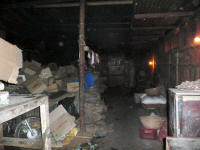 Daporijo is beside a river surrounded by
hills, a lovely setting. Then you drive up the muddy main street. Yes it had
rained for most of the day but it would be bumpy when dry. We stayed at the best
hotel in the town because we wanted to get the early bus. The hotel reception is
also the restaurant cash point. The entrance to the rooms is past the kitchen,
the large wood fired stove and the wood storage then up the steps. The rooms are
very basic and there were only doubles - unless you were Indian! My bag was
soaked even though it had been covered with a tarpaulin. Once again every piece
of clothing was wet, so much for a waterproof bag! Jay hung lines all over the
room and I slept with the fan going and under a blanket. I knew there were
mosquitoes but felt this would be good enough. Of course mosquitoes know a good
meal when it is in town and they joined me under the blanket or perhaps they
were fleas, at least they were not bedbugs. The
clothing was dry by morning. I have now lined the bag with the picnic blanket
but this will be a nuisance if I want to use it. Why did we stop at Daporijo - because to go on to Along would be too far, too tiring and the driver
would probably fall asleep at the wheel.
Daporijo is beside a river surrounded by
hills, a lovely setting. Then you drive up the muddy main street. Yes it had
rained for most of the day but it would be bumpy when dry. We stayed at the best
hotel in the town because we wanted to get the early bus. The hotel reception is
also the restaurant cash point. The entrance to the rooms is past the kitchen,
the large wood fired stove and the wood storage then up the steps. The rooms are
very basic and there were only doubles - unless you were Indian! My bag was
soaked even though it had been covered with a tarpaulin. Once again every piece
of clothing was wet, so much for a waterproof bag! Jay hung lines all over the
room and I slept with the fan going and under a blanket. I knew there were
mosquitoes but felt this would be good enough. Of course mosquitoes know a good
meal when it is in town and they joined me under the blanket or perhaps they
were fleas, at least they were not bedbugs. The
clothing was dry by morning. I have now lined the bag with the picnic blanket
but this will be a nuisance if I want to use it. Why did we stop at Daporijo - because to go on to Along would be too far, too tiring and the driver
would probably fall asleep at the wheel.
We had dinner in the restaurant which had the usual menu. Jay and Jim took out the bottle of beer they had bought in Ziro and proceeded to open it. We were quickly asked to move to another more secluded table. The beer was put on the floor so it was not obvious. Very few restaurants allow alcohol to be consumed on the premises.
Saturday 8 to Monday 12 May 2008, Along, Arunachal Pradesh
The bus left at 7:00am but we wanted to be there in time to
ensure we had seats. We also purchased a seat for the luggage to ensure it
stayed inside and dry. Naturally the bus was not crowded, ever, and the sun shone
brightly all day! The aisles were packed with large bags of
rice and other parcels at times. The driver was also given letters and small
packages to deliver along the way. The fare collector did not seem to collect
many fares from the passengers. Most did not pay. Maybe they have season tickets
or there is free transport for locals or the conductor knows them. The scenery
was great. Green hills, rivers and once again a variety of houses ranging from
traditional to modern to combinations of both.
We arrived mid afternoon, booked into the hotel and did little else that day.
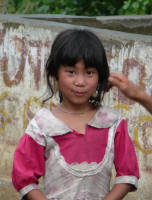
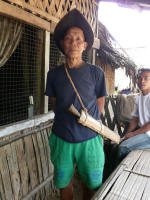
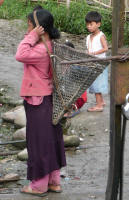
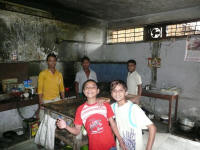
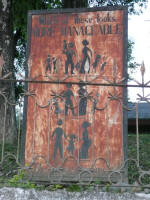
Sunday
we went for a walk through some Adi
Galong villages. We took an auto-rickshaw to Pobdi and walked across the Yomgo
River on a footbridge to Paia. The houses were typical of the Adi style we had
seen from the bus but much neater. The granaries had round wooden plates on the
poles supporting the granaries. These prevent the rats from getting to the
grain.
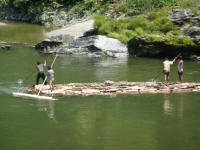
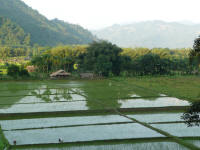
We were invited into an election campaign party. The candidate was an independent and already had 300 of the 480 votes tied in. There were visitors to start with, both men and women but they left soon after and it became an all male affair. We were introduced to the village chief, his father, the owner of the house and the candidate. The drinks came round, first Fanta orange then the local wine which tasted a bit like brandy, much nicer than the rice wine at Ziro. Everyone was given some potatoes and beef wrapped in a banana leaf. A piece of the heart came separately, much more tender than the other meat. A woman brought a bucket and jug of water around to wash our hands. Then the main meal arrived, a large package of rice with the dhal and meat coming separately. Once again the beef was chewy. The older men were dressed in the traditional garb of loin cloth, waist-coat, knife and bamboo hat. The younger men had more western clothing. The women wore the traditional skirt with a blouse but because it was a special occasion they had a scarf to match their skirt. The young men could speak at least some English and translated for us. There was much laughter. We were asked why we hadn't built the road bridge yet! This caused great merriment because we obviously had no influence, but it was a political party. I was asked if I was married to both Jim and Jay. The young man who translated the question was giggly with embarrassment. I answered that I had a husband somewhere else. That evinced more laughter. Jim asked for some words to take back to Australia. The father of the chief gave a prayer asking for our safe return to Australia.
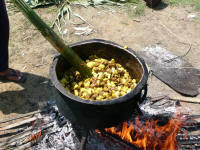
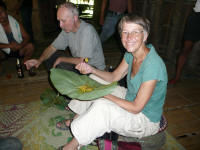
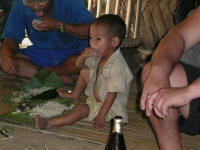
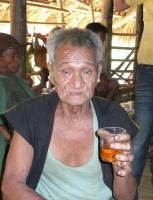
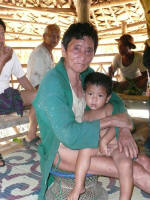
Once we extricated ourselves from the party, which was degenerating with all the alcohol being consumed, we walked along the river to another footbridge about 3 k downstream. It took a while to find the footpath and we lost it at times. It went along rice paddies, over gullies using single logs and over fences using stiles. Part of the time we went over river rocks. Eventually we arrived at the bridge. Strong wire is used as the basic construction to give it strength. Bamboo is used for the rest. Lengths of bamboo is bent into a 'u' shape and placed about 50cm apart so you are walking through a tunnel open to the sky. The floor is made up of flattened bamboo. It is strong enough and there is no danger of falling into the water quite a few meters below. Jim went first and was the only one on the bridge until the last meter. Jay went next with a man coming towards him. The man was really considerate though and kept still for most of Jay's crossing. Then he ran the last 10 meters! Now it was my turn. It was a bit scary because the bridge swings from side to side and I could not reach either of the sides for support. Then peak hour arrived. The bridge started going in all directions. At most there were 4 people at a time on the bridge with me but they had to pass me while I crouched down for balance and support. Once the bridge sort of stabilised I went on until these fast walkers upset the balance once again. Eventually I made it, but there was a big adrenaline rush while I was on that bridge. And we still had 5 kilometres to walk back to Along! We headed along the main road but only managed to pick up an auto rickshaw near town. Even that last kilometre of being driven was heaven. By this time my back hurt from strolling, standing, sitting on a stool and walking, my feet were sore and my legs tired. A hot shower and a long rest were very welcome.
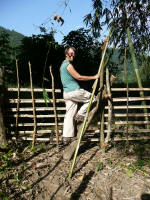
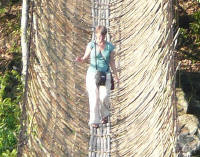
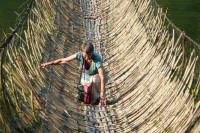
Monday was spent relaxing and keeping cool except for going to the local museum and market. The museum was interesting and I managed to pick up some thick plastic at the market. I will use this to line my bag instead of the picnic blanket. I hope it works.
At least that was how it went until Valot, a tourist guide arrived. He agreed to take us to an Adi Miyong village then to the practice session for a local dance festival in an Adi Galong village. The Adi Miyong village was across the river and then in the opposite direction to the Adi Galong villages. We all got ready and went off in the rickshaw across the river and turned right towards the Adi Galong villages past where we had been yesterday. He had forgotten that we were leaving tomorrow and was thinking we could go to the Adi Miyong village then. Naturally we arrived 2 hours too early for the dancing which only started after dark. Valot said he had not known the time for the dancing. I could have told him it would only start after dark! It would have worked out fine if we had gone to the Adi Miyong village first. What a waste of effort and money! We came straight back to the hotel and did not bother returning for the dancing.
Tuesday 13 to Wednesday 14 May 2008, Pasighat, Arunachal Pradesh
It was a late start again just the way I
like it. There was time to see the Donyi Polo Dere (House of worship, sometimes
called a
Saiza Thokpa).
This is basically a large hall where everyone sits on the floor on mats with a
tower at one end. The tower looks a little like a Buddhist tower. There is an
Adi Emporium nearby where clothes and cloth are sold. I bought a piece of cloth
that can be used as an Adi skirt. It is wrapped around the waist and tucked into
itself. The women in town use a pin though. This will at least stay on as it is
not slippery like the pashima.
Once again we drove through green hills and along the Siang river. There seemed to be more natural forest but still a lot of slash and burn agriculture. The sumo driver was good, definitely not a cowboy. The tape music was reasonable and not overly loud and he only used his horn when he couldn't see far enough ahead. We stopped regularly either to let on passengers, drop off parcels or just for a break. This is the first time I remember that my bum did not get sore from sitting down.
Pasighat is on the Siang river and less than 200 meters above sea level. It is hot and humid, the cool air seems to be behind us unfortunately. There is little of interest, except to organise the trip to Dibrugarh. We took an auto rickshaw to the hotel mentioned in the LP where sumos plus the ferry could be arranged. We had already seen it way out of town, quite upmarket. The rickshaw driver started out that way then thought about it, turned round and took us back a short distance past the market to a hotel of the same name. We could have walked! We paid him the price to take us to the upmarket hotel though since he actually took us to where we needed to go, rather than where we thought we wanted to go. It was easy to arrange tickets for the next morning. Another early start because the sumo had to arrive before the only ferry left.
Walking around the town that evening we were invited to a welcome home ceremony for the Deputy Director of Community Health. Men one side, women the other side of the hall. He had just returned from Peru and the USA where he did a course on Community Health and discussed issues with officials in those countries. He gave a speech on his travels. It was partly in English so we could follow the gist of it. He talked about the difficulty of obtaining visa, the amount of beef on the menu, the cleanliness of the toilets and the ease of using an ATM among other issues. I can imagine that some of the issues he discussed with other officials was TB, Leprosy and HIV/AIDS. All 3 seem to be major issues in the North East, not least the stigma attached to leprosy. We received another Bihu scarf and a bunch of artificial flowers. I graciously gave mine to the man's wife. She had been translating for me. She is also the Matron of a nursing home and malaria is one of common ailments she has to deal with. After the speeches, one given by Jim, and some tea there was some traditional dancing. We all joined in clapping to the music. Once again a great experience.
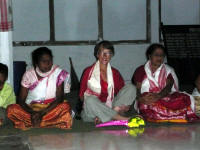
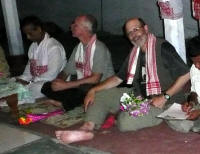
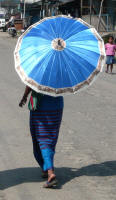
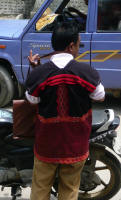
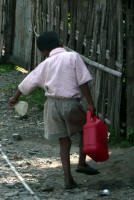
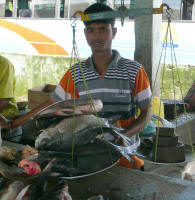
Thursday 15 May 2008, Dibrugarh, Assam
The ferry on the Brahmaputra usually leaves from a dock about 30k from Pasighat. This changes with the season and the current location of the river banks. We ended up driving many, many kilometres and then went upstream to Dibrugarh. Dibrugarh is actually downstream from Pasighat! The trip into Dibrugarh from the ferry did not take all that long though.
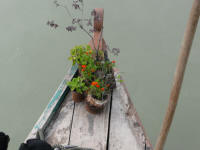
After we arrived and booked into the hotel we started discussing our next steps and realised that our further plans were very vague. Jim wanted to stay in Dibrugarh and meet with Abid and perhaps go on a bike ride. Jay and I were talking about going to Varanasi. He was very enthusiastic which made me realise that I wasn't. I had thought to revisit Varanasi and Agra on the way to Delhi but now changed my mind and decided to head straight to Delhi. Next morning Jay and I booked our tickets on the same train leaving that evening, he to Varanasi, me to Delhi. This time I took air-conditioned beds. Jay has yet to experience sleeper class (non-air conditioned)! The journey entailed 3 nights and 2 days to Delhi as it was the Mail train not the Express. The Express was fully booked for days so this was the quickest way to go.
Jim managed to contact Abid, the young man who had been organising the bike tour before his mother died and he had to cancel. He took us on a tour of the town, there is really not much to see but we certainly went to places that most tourists would never see, including a bar out of town. We also saw the Shri Radhakrishna Devasthan built by a local tea Plantation owner in 1979.
NOTES ON THE NORTH EAST:
It is expensive for the lone budget traveler as single rooms are not easy to find and a single person must go into a double room. Hotels are definitely more expensive than in the south. They are on a par with the large cities.
Most people eat with a spoon or other implement, very few use their hands.
The people are friendly and they do not hassle you and look at you as a walking money bag. Assam is the exception but even there it is not as bad as elsewhere in India. It is a real pleasure to travel through the area
Friday 16 to Sunday 18 May 2008, on the train
It was quite an emotional farewell to Jim. We have spent so much time together and have had a really great time. We became used to each other's foibles and we are definitely going to miss each other. He is now on his own. Jay and I have 2 days on the train before we part. What a pleasure to be in air-conditioning. Outside it is hot, steamy and dusty. Inside it is cool and clean. After 3 nights I did not feel grimy and like a lump of wet grease, definitely better than sleeper class. Jay left on the evening of the second day and once again it was an emotional farewell. Now we are all on our own.
After Jay left I tried a Soduko photocopied from Jay's Extreme Soduko and solved it. This inspired the others that we had been travelling with and they all had to try it. In the end there were 4 people doing Soduko!
The train went through Dimapur in the early hours of the first morning. We can now both say we have been to Nagaland! Jay was awake and hopped onto the station, so he has a slightly bigger claim.
Monday 19 to Friday 23 May 2008, Delhi
The
train arrived a little late. The auto rickshaw driver asked more than double
what I expected but was backed by hotel management so I paid most of it. I spent the morning asleep
then went to the Tourist Bureau to find out where the embassies were. I walked
to Connaught Place to get some exercise after 2 days on the train. It is not
very far from New Delhi Train Station and the hotel. It is a very modern area
and I will have to return to find an LP for China. I may also be able to sell
some excess books there.
An early night was called for as I expected to be very busy in the morning. My room was right behind reception. At 10:30pm I asked reception to turn the TV down, I could hear every word! At 4:30am new guests banged on the locked door. It took about half an hour for them to be registered all talking in loud voices. At 6:00am the staff started their day talking right outside my room. So much for getting some sleep! I eventually gave up, rose, dressed, made sure I had everything I needed for the embassies, had some breakfast and asked for another room. I was promised one on my return. I went to the Chinese Embassy first but achieved very little except to obtain the application form and confirm I did not require a letter from my embassy. Next the Australian Embassy for the letter required by Pakistan. I had already had all the stamped pages in my passport photocopied as required in Iran. Next the Pakistan Embassy. The application form had to be typed, one copy only. Typists had set up shop nearby so that was easy. I did need the letter from my embassy but not all the photocopies of the passport. I had to deposit the fee into a specific bank and return with the deposit slip. Unfortunately the banks were closed for some reason so I would have to return the following day. I had an auto rickshaw for the whole trip to make it easy but of course I was overcharged. Unfortunately, according to the hotel management, there is no easy way by public transport and until I get to grips with that I am stuck with rickshaws. I slept the afternoon away in my new room, right on the street, but I can ignore street noise its voices that get me. Wednesday meant going to the bank then the embassy. Again I was overcharged by the auto rickshaw driver. This is now the third day in a row! I was told to return on Thursday and here I thought it would take days! Thursday turned out to be an interview! The good news this is that the auto rickshaw driver wanted 4 times the going rate. I told him in very unpleasant terms what he could do with it and stormed off intending to walk the 10 k. Naturally once on the main road I asked at a bus stop if there was a bus. Yes it would drop me within 200 meters of he embassy! The embassy said come back Friday. I returned to the same bus stop and was told of a better bus which would take me closer to the hotel. Friday I took the bus, picked up my passport with visum and walked to the Chinese embassy. They are all close together. Unfortunately because China has no open land borders with India I needed a return flight ticket. Next stop Pakistan.
I was able to get a train for early the next morning. I paid the hotel bill because it would be such an early start. Unfortunately I forgot I had paid a hefty deposit and the owner said I did not need the receipt. Stupid me. It was only later that I realised I had paid the full amount and therefore overpaid by the INR1,000 deposit. By this time my fuse was very short when it came to being ripped off. At least the owner agreed that I had paid the full amount and therefore should receive the deposit back. It had been a mistake. I do really 'believe ' him. 5 days in Delhi, 3 days ripped off, admittedly not by enormous amounts, 1 day attempted rip-off, 1 day almost succeeded in being ripped off. Not a good record on the honesty of people in Delhi! It has left a very bitter taste. Obviously Delhi is a city to be avoided.
I did not see much of the city either
because of chasing after visa.
I was in an air-conditioned chair car on the train. A young Korean sat next to me and we agreed to go through the border together to save some costs on shared auto rickshaws. In the end this did not turn out to be much as we used the bus and had to take a peddle rickshaw each from Attari to the border, 3 k, so that is fair enough when you consider the luggage.
| Averages | Rand | Indian Rupees | USD | ||
| Cost of transport per kilometer | 0.12 | 0.61 | 0.01 | ||
| Hotels per night | 49.77 | 259.74 | 6.07 | ||
| Total | |||||
| Kilometers traveled | 16 747 | ||||
| Days in country | 147 |
NB: Budget hotels were used and the over 60 concession on trains